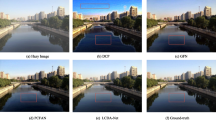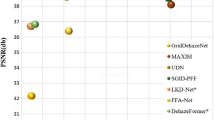Abstract
Recently convolutional neural networks based methods have achieved significant improvements in image dehazing. However, these algorithms still face the challenge of producing haze-free images while preserving credible contrast and color fidelity. In this paper, we propose an adaptive feature fusion network to remove the haze and ensure realistic details from global and local perspectives. On the global scale, we learn compact feature representations by progressive downsampling, which can provide the overall information from the encoded high-level semantic context. Besides, dilated convolution is adopted to expand the receptive fields, which can effectively capture the contextual information and alleviate the details loss of resolution reduction. Correspondingly, the proposed method employs a local branch to enrich the feature representations and further emphasize the meaningful information for image details recovery. To this end, we design the residual dense attention block (RDAB) which encourages mid-level feature aggregation and persist memory by dense connections. Within the RDAB, a boosted attention mechanism (BAM) is presented to explicitly model the feature interdependencies between channels under different scales. Then, a weighting operation is conducted to balance the information flow received from these scales. Moreover, an adaptive weighted network is developed to achieve a good trade-off between the contributions of global and local information for semantical image dehazing. To take full account of quality evaluation, we use the L1 smooth loss and perceptual loss to reconsturct the dehazed images. Extensive evaluation demonstrates the superior performance of our method is 4db PSNR values and 0.1 SSIM value more than the related work while preserving credible contrast and color fidelity.







Similar content being viewed by others
Explore related subjects
Discover the latest articles and news from researchers in related subjects, suggested using machine learning.References
Ancuti C, Ancuti C, Timofte R, De Vleeschouwer C (2018) O-haze: a dehazing benchmark with real hazy and haze-free outdoor images. In: Proceedings of the IEEE conference on computer vision and pattern recognition workshops, pp 754–762
Bahat Y, Irani M (2016) Blind dehazing using internal patch recurrence. In: IEEE International conference on computational photography, pp 1–9
Bansal M, Kumar M, Kumar M, Kumar K (2021) An efficient technique for object recognition using shi-tomasi corner detection algorithm. Soft Comput 25(6):4423–4432
Berman D, Treibitz T, Avidan S (2016) Non-local image dehazing. In: Proceedings of the IEEE conference on Computer Vision and Pattern Recognition, pp 1674–1682
Breiman L (2001) Random forests. Mach Learn 45(1):5–32
Chen S, Chen Y, Qu Y, Huang J, Hong M (2019) Multi-scale adaptive dehazing network. In: Proceedings of the IEEE Conference on Computer Vision and Pattern Recognition Workshops, pp 0–0
Chhabra P, Garg NK, Kumar M (2020) Content-based image retrieval system using orb and sift features. Neural Comput Appl 32(7):2725–2733
Dai C, Lin M, Wu X, Zhang D (2020) Single hazy image restoration using robust atmospheric scattering model. Signal Process 166:107257
Dong Y, Liu Y, Zhang H, Chen S, Qiao Y (2020) Fd-gan: Generative adversarial networks with fusion-discriminator for single image dehazing. In: Proceedings of the AAAI Conference on Artificial Intelligence, vol. 34, pp 10729–10736
Garg D, Garg NK, Kumar M (2018) Underwater image enhancement using blending of clahe and percentile methodologies. Multimed Tools Appl 77 (20):26545–26561
Gupta S, Kumar M, Garg A (2019) Improved object recognition results using sift and orb feature detector. Multimed Tools Appl 78(23):34157–34171
Gupta S, Thakur K, Kumar M (2021) 2d-human face recognition using sift and surf descriptors of face’s feature regions. Vis Comput 37(3):447–456
He K, Sun J, Tang X (2010) Single image haze removal using dark channel prior. IEEE Trans Pattern Anal Mach Intell 33(12):2341–2353
Hu J, Shen L, Sun G (2018) Squeeze-and-excitation networks. In: Proceedings of the IEEE Conference on Computer Vision and Pattern Recognition, pp 7132–7141
Jeong D, Kim BG, Dong SY (2020) Deep joint spatiotemporal network (djstn) for efficient facial expression recognition. Sensors 20(7):1936
Kim JH, Kim BG, Roy PP, Jeong DM (2019) Efficient facial expression recognition algorithm based on hierarchical deep neural network structure. IEEE Access 7:41273–41285
Kim TK, Paik JK, Kang BS (1998) Contrast enhancement system using spatially adaptive histogram equalization with temporal filtering. IEEE Trans Consum Electron 44(1):82–87
Kumar A, Kumar M, Kaur A (2021) Face detection in still images under occlusion and non-uniform illumination. Multimed Tools Appl 80(10):14565–14590
Kumar M, Chhabra P, Garg NK (2018) An efficient content based image retrieval system using bayesnet and k-nn. Multimed Tools Appl 77(16):21557–21570
Ledig C, Theis L, Huszár F, Caballero J, Cunningham A, Acosta A, Aitken A, Tejani A, Totz J, Wang Z, Shi W (2017) Photo-realistic single image super-resolution using a generative adversarial network. In: Proceedings of the IEEE Conference on Computer Vision and Pattern Recognition, pp 4681–4690
Lei J, Li X, Peng B, Fang L, Ling N, Huang Q (2020) Deep spatial-spectral subspace clustering for hyperspectral image. IEEE Trans Circ Syst Video Technol:1–12. https://doi.org/10.1109/TCSVT.2020.3027616
Li B, Peng X, Wang Z, Xu J, Feng D (2017) An all-in-one network for dehazing and beyond. arXiv:1707.06543
Li B, Ren W, Fu D, Tao D, Feng D, Zeng W, Wang Z (2018) Benchmarking single-image dehazing and beyond. IEEE Trans Image Process 28(1):492–505
Li F, Bai H, Zhao Y (2020) Learning a deep dual attention network for video super-resolution. IEEE Trans Image Process 29:4474–4488
Li K, Li Y, You S, Nick B (2017) Photo-realistic simulation of road scene for data-driven methods in bad weather. In: Proceedings of the IEEE International Conference on Computer Vision Workshops, pp 491–500
Liu X, Ma Y, Shi Z, Chen J (2019) Griddehazenet: Attention-based multi-scale network for image dehazing. In: Proceedings of the IEEE International Conference on Computer Vision, pp 7314–7323
Mei K, Jiang A, Li J, Wang M (2018) Progressive feature fusion network for realistic image dehazing. In: Asian conference on computer vision, pp 203–215
Meng G, Wang Y, Duan J, Xiang S, Pan C (2013) Efficient image dehazing with boundary constraint and contextual regularization. In: Proceedings of the IEEE International Conference on Computer Vision, pp 617–624
Narasimhan SG, Nayar SK (2000) Chromatic framework for vision in bad weather. In: Proceedings IEEE Conference on Computer Vision and Pattern Recognition, pp 598–605
Narasimhan SG, Nayar SK (2002) Vision and the atmosphere. Int J Comput Vis 48(3):233–254
Pan Z, Yu W, Lei J, Ling N, Kwong S (2021) Tsan: Synthesized view quality enhancement via two-stream attention network for 3d-hevc. IEEE Trans Circ Syst Video Technol:1–14. https://doi.org/10.1109/TCSVT.2021.3057518
Peng B, Lei J, Fu H, Jia Y, Zhang Z, Li Y (2021) Deep video action clustering via spatio-temporal feature learning. Neurocomputing:1–9. https://doi.org/10.1016/j.neucom.2020.05.123
Qu Y, Chen Y, Huang J, Xie Y (2019) Enhanced pix2pix dehazing network. In: Proceedings of the IEEE Conference on Computer Vision and Pattern Recognition, pp 8160–8168
Raanan F (2014) Dehazing using color-lines. ACM Trans Graph 34 (1):1–14
Raikwar SC, Tapaswi S (2020) Lower bound on transmission using non-linear bounding function in single image dehazing. IEEE Trans Image Process 29:4832–4847
Reda M, Zhao Y (2018) Haze removal methods: a comprehensive review. In: 2018 IEEE CSAA Guidance, navigation and control conference (CGNCC), pp 1–7. IEEE
Ren W, Liu S, Zhang H, Pan J, Cao X, Yang MH (2016) Single image dehazing via multi-scale convolutional neural networks. In: European conference on computer vision, pp 154–169
Ren W, Ma L, Zhang J, Pan J, Cao X, Liu W, Yang MH (2018) Gated fusion network for single image dehazing. In: Proceedings of the IEEE Conference on Computer Vision and Pattern Recognition, pp 3253–3261
Ren W, Pan J, Zhang H, Cao X, Yang MH (2020) Single image dehazing via multi-scale convolutional neural networks with holistic edges. Int J Comput Vis 128(1):240–259
Santra S, Mondal R, Chanda B (2018) Learning a patch quality comparator for single image dehazing. IEEE Trans Image Process 27(9):4598–4607
Simonyan K, Zisserman A (2014) Very deep convolutional networks for large-scale image recognition. arXiv:1409.1556
Stark JA (2000) Adaptive image contrast enhancement using generalizations of histogram equalization. IEEE Trans Image Process 9(5):889–896
Sulami M, Glatzer I, Fattal R, Werman M (2014) Automatic recovery of the atmospheric light in hazy images. In: IEEE International conference on computational photography, pp 1–11
Tang K, Yang J, Wang J (2014) Investigating haze-relevant features in a learning framework for image dehazing. In: Proceedings of the IEEE Conference on Computer Vision and Pattern Recognition, pp 2995–3000
Vaswani A, Shazeer N, Parmar N, Uszkoreit J, Jones L, Gomez AN, Kaiser Ł, Polosukhin I (2017) Attention is all you need. Adv Neural Inf Process Syst 30:5998–6008
Vinyals O, Toshev A, Bengio S, Erhan D (2015) Show and tell: a neural image caption generator. In: Proceedings of the IEEE Conference on Computer Vision and Pattern Recognition, pp 3156–3164
Wang F, Jiang M, Qian C, Yang S, Li C, Zhang H, Wang X, Tang X (2017) Residual attention network for image classification. In: Proceedings of the IEEE Conference on Computer Vision and Pattern Recognition, pp 3156–3164
Wang Z, Bovik AC, Sheikh HR, Simoncelli EP (2004) Image quality assessment: from error visibility to structural similarity. IEEE Trans Image Process 13(4):600–612
Yeh CH, Huang CH, Kang LW (2019) Multi-scale deep residual learning-based single image haze removal via image decomposition. IEEE Trans Image Process 29:3153–3167
Zhang H, Patel VM (2018) Densely connected pyramid dehazing network. In: Proceedings of the IEEE Conference on Computer Vision and Pattern Recognition, pp 3194–3203
Zhang Y, Ding L, Gaurav S (2017) Hazerd: an outdoor scene dataset and benchmark for single image dehazing. In: 2017 IEEE International conference on image processing, pp 3205–3209
Zhu L, Fu CW, Brown MS, Heng PA (2017) A non-local low-rank framework for ultrasound speckle reduction. In: Proceedings of the IEEE Conference on Computer Vision and Pattern Recognition, pp 5650–5658
Acknowledgements
This work was supported in part by National Natural Science Foundation of China (No. 61972023) and Fundamental Research Funds for the Central Universities (2019YJS031, 2019JBZ102).
Author information
Authors and Affiliations
Corresponding author
Additional information
Publisher’s note
Springer Nature remains neutral with regard to jurisdictional claims in published maps and institutional affiliations.
Rights and permissions
About this article
Cite this article
Wang, Z., Li, F., Cong, R. et al. Adaptive feature fusion network based on boosted attention mechanism for single image dehazing. Multimed Tools Appl 81, 11325–11339 (2022). https://doi.org/10.1007/s11042-022-12151-4
Received:
Revised:
Accepted:
Published:
Issue Date:
DOI: https://doi.org/10.1007/s11042-022-12151-4




